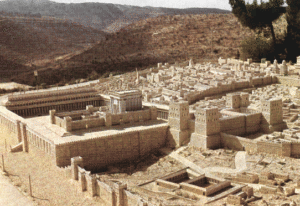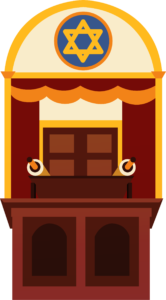Judaism in the First Century Palestine – Beliefs & Practices
LESSON FOCUS
Jesus lived, taught and died in Palestine in the first century – and the church was born in that social, cultural and religious context. In order to understand Jesus and the early church well, we need to know about this setting. This lesson will introduce you to the key beliefs in Judaism at that time – there were five core of common beliefs and practices during the Second Temple period – One True God, Israel as God’s Chosen People, God’s Laws, God’s Land & Temple, Festivals and Hope for the Future. We will be looking at the first four.

BELIEFS & PRACTICES


Scholars today speak of the ‘second temple’ period of Judaism, the time from the return from the Babylonian exile (sixth and fifth centuries BC) to AD 70. The first temple was Solomon’s temple, built in the tenth century BC and destroyed by the Babylonian invaders in the sixth century (the OT book of Lamentations records the reaction of devout Jews to this cataclysmic event). The ‘second temple’ was the one built when the Jews returned from exile (the OT books of Ezra and Nehemiah describe the rebuilding process). By the time Jesus was born, Herod the Great’s (third) temple was being built, starting in 19 BC and finally being completed in AD 64 – just in time to be destroyed by the Romans in the Jewish War of AD 66-70. The Judaism of the second temple period, from the fifth century BC to the first century AD, is key to understanding Jesus’ life and work.
One True God
First and foremost, Jewish people in the ancient world were marked out by their belief that there was only one true God, Yahweh (the name this God has in the OT, derived from the Hebrew verb meaning ‘to be’; (Exod. 3:13-15). This monotheism (belief in one God – Deut. 6:4-5; cf. Ps. 96:4-5) contrasted sharply with the many gods of other faiths, whether the Greek and Roman gods known to us through mythology (Jupiter/Zeus, Mercury/ Hermes, etc.) or the many local deities in different parts of the ancient world.
Second, with the belief in one true god went a rejection of the worship of other gods – in particular, of the worship of idols, which were physical representations of people, animals or plants treated as objects of prayer and religious devotion (Isa. 40–55 particularly Isa. 44:9-20 is typical, portraying a craftsman who turns half of a tree into an idol to worship, and the other half into firewood)
Third, Judaism rejected syncretism, that is, the attempt to identify the gods of a people with the gods of another people. Syncretism had been around at least since the Israelites had entered the promised land in the second millennium BC, and was seen as a cause of both the Assyrian exile of Israel in 722 BC (Amos 5:25-27) and the Babylonian exile of Judah in 587 BC (Jer. 19:10-13). The problem was that syncretism was a standard way of subduing a conquered people in the ancient world. For Example, when Greek and Romans would conquer a people and then identify the gods of that nation with their own gods (Zeus for Alexander/Greeks) or Jupiter (for the Romans). Antiochus Epiphanes installed an altar to Zeus in the Jewish temple in Jerusalem in 167 BC.
The monotheism of the Jews had two major characteristics, both of which made large truth claims over against other faiths: the Jews were creational and providential monotheists and ruled out four views which were common in the period of Jesus and the early Christians.
Creational Monotheism
Central to Judaism was the belief that Yahweh was the creator of the world, seen particularly in the creation stories of Gen. 1–2, but also throughout the OT (e.g. Pss 89, 104). Judaism’s claim that Yahweh was the creator of all people everywhere implied that everyone should worship him alone. In particular, believing in Yahweh as creator ruled out four views which were common in the period of Jesus and the early Christians.
- Henotheism was a common belief that each nation should worship its own god(s), without believing that there is only one true God. Gen. 1:1ff. immediately opposes this view by its strong assertion that Yahweh is the creator God who alone made the whole world.
- Pantheism identified god with the natural order – ‘god’ was a name for all that exists. On this view, ‘god’ was intimately involved in the created world, and it was legitimate to worship the created world. By contrast, Gen. 1:1 sets Yahweh apart from the universe: he created it and is distinct from it.
- Epicureanism was a Greek philosophy which included the belief that the gods were not interested or involved in human life. Thus prayer, worship and sacrifice were all pointless. By contrast, Jewish creational monotheism included the belief that Yahweh was intimately involved in the world: he both created it and sustained it moment by moment (see also Isa. 40:26; Pss 65:9-13; 135:6-7).
- Paganism saw the universe as populated by a large number of divine beings, each with different areas which they controlled – the weather, the sea, the crops, particular nations, the stars or planets, etc. With this belief went the view that these gods were capricious – their reactions depended on how they were feeling. So people sought ways to placate the gods in order to persuade them to act kindly. By contrast, Gen. 1 portrays Yahweh as the creator of these elements within the universe, including the sun, moon and stars (vv. 14-18; cf. Isa. 40:26), thus claiming that the pagan ‘gods’ were no gods at all.
PROVIDENTIAL MONOTHEISM
Judaism was and is committed to the belief that this one true God reigns. He is the true ruler of the universe, and he orders its existence in line with his purposes (e.g. Pss 10:6; 22:28; 93:1; 96:10). God’s usual way of reigning is to work in and through ‘natural’ events; hence he can be said to be responsible for the rise and fall of kings and emperors in all the nations (e.g. Isa. 40:22- 24; 45:1-8, Amos 3:6).
But that raised a large question: if God was truly ordering the events of the world, why was there so much evil in the world? Was Yahweh powerless to do anything about it or did he not care? Jews rejected both of those alternatives in favour of the belief in election, the second major mark of their faith.
GOD HAS CHOSEN ISRAEL
Election is the belief that the creator of the universe has chosen Israel to be his people, and has committed himself to them by a covenant. This is how Judaism understood God’s response to evil, and it is worthwhile noticing that the biblical authors in both OT and NT are much more interested in what God is doing about evil than in where evil came from. Evil is recognized as a reality which God is acting to bring to an end. The means Yahweh is using to bring evil to an end is the people of Israel. God called this people to be his own special people through their ancestor Abraham, in order that the creation order might be restored.
In three key passages God promises to Abraham that he will have many descendants (Gen. 15:1-6), that the whole earth will be blessed through him and his family (Gen. 12:1-3), and that the nation descended from him will be given their own land (Gen. 15:17-21). Thus the purpose of calling Israel was not for the nation’s own sake, but so that they might be a light to the world, enabling the world to respond to its creator God (e.g. Isa. 42:6; 49:6; 51:4).
Not only had Yahweh called the nation into being as his own people, he had saved them from danger time after time. The language used for this is often ‘redeem’ and ‘redemption’, which means ‘to buy back’: God redeemed the people from slavery in Egypt through the leadership of Moses at the Exodus. The return from the Babylonian exile of the sixth century BC was pictured using ‘new Exodus’ language, suggesting that God was doing again what he had done in the time of Moses (Isa. 40–55).
The expression of God’s commitment to Israel was in the form of a covenant. This was a commitment marked by solemn oaths (cf. Gen. 15:17-21). Human covenants could be between equals, or between a conquering army and a conquered people; God’s covenant with Israel is most like the second type – hence the later chapters of Deuteronomy promise good things to the people if they keep the terms of the covenant (28:1-14; 30:1-10) and bad things if they break the conditions of the covenant (27:14-26; 28:15-68; 29:17-28).
GOD HAS PROVIDED A WAY TO LIVE
The law (or torah) was God’s gracious gift to the people he had chosen and redeemed, in order to show them how he wished his people to live (Deut. 7:7-11), and it was highly prized by first-century Jews. The commandments are being given to a people who are already the people of God, for he has brought them out of slavery in Egypt to be his own people. They are given so that they may know how to conduct their national, family and individual lives in line with God’s will. Keeping the law was the key marker of being a member of God’s people, for the torah set Israel apart from the other nations.

During the Babylonian exile worship had begun to centre more on reading the torah and prayer than on the temple services – for there was no Jewish temple in Babylon. The return from exile established the centrality of the law to Jewish worship, particularly through the work of Ezra the scribe (see Neh. 8). This developed over the years into the institution of the synagogue, a meeting for worship focused on the reading of Scripture and prayer. It became particularly important in diaspora Judaism – for they lacked access to the Jerusalem temple – but was also important in the land of Israel itself, as we know from Jesus’ regular attendance (Luke 4:16).
Three facets of the law were particularly important by the time of Jesus – namely circumcision, the Sabbath and the food laws – and these were treated as ‘boundary markers’ which showed who truly belonged to the one true God.
In circumcising baby boys on the eighth day a physical mark was being imposed on a child which identified him as Jewish, and the OT traces this ceremony back to Abraham, the father of the nation (Gen. 17:9-14). For example, So when Antiochus made circumcision illegal in 167 BC (1 Macc. 1:60-61), he was directly attacking the distinctiveness of Judaism. Similarly, a concern among devout Jews about the impact of Greek culture was that it led to young Jewish men who trained in gymnasiums (where the athletes were naked) trying to remove the marks of circumcision so as to avoid ridicule because they were Jews:
Resting on the Sabbath day (Saturday) was also important to devout Jews, for that was commanded both in creation (Gen. 2:2-3) and in the ten commandments (Exod. 20:8- 11). During the Maccabean revolt, one group of faithful Jews even refused to defend themselves on the Sabbath, and as a result were killed (1 Macc. 1:31-38).
The food laws required Jews to eat only ‘kosher’ meat, which came from certain kinds of animals and which had had the blood drained out of it first (see Lev. 11:1- 23; Deut. 14:3-21). They were forbidden to eat meat from other animals, particularly pigs, which were regarded as ‘unclean’ (Deut. 14:8). Jews therefore refused to eat with non-Jews, for they could not be confident that the meat they were eating was ‘kosher’ (and this is the probable background to the disputes about Jewish Christians eating with Gentile Christians in Gal. 2:11-14). Again, Antiochus Epiphanes made it illegal to keep these laws and therefore met with resistance from devout Jews (1 Macc. 1:62-63).
For faithful Jews, keeping the law was vital for two reasons: first, to maintain their standing within the community of God’s people, those whom he would redeem when he acted to free Israel from her present bondage under the Romans.
Second, maintaining the distinctives of the torah – circumcision, the Sabbath and the food laws – preserved Jewish national identity at a time of pagan rule. So at the time of Jesus the law was central to Judaism; it would be hard to overstate its importance.
GOD HAS GIVEN THE PEOPLE A LAND, FOCUSED IN THE TEMPLE

A key element in God’s covenant with Abraham was the promise of a land (Gen. 12:1; 15:18-21) God renewed this promise with Moses at the time of the Exodus (Exod. 3:8), and it became a key element in Judaism. Thus, Deuteronomy records a warning that if the people were unfaithful to God, they would be scattered from the land (Deut. 28:64), as well as a promise that if they were exiled in another land and genuinely turned away from their misdeeds and wholeheartedly returned to God, God would bring them back to the land (Deut. 30:1-5; cf. 1 Kgs 8:33-34).
It was through these promises that Jewish thinkers interpreted the exile in Babylon in the sixth century BC and the return some fifty years later – they saw the exile as God’s punishment for them breaking the terms of the covenant, and the return to the land under Ezra and Nehemiah as God’s gracious act of restoration and forgiveness.
Because the land was promised to them by God, the Jews saw it as holy – for God lived there among them (Num. 35:34). So to rebel against God by failing to live as the law required was to make the land unclean. Equally, the situation in the first century AD, when Gentiles were in control of the land, was seen as making the land unclean (more fully, see Wright 1992, 226-7).
THE TEMPLE, SECTIONS AND SERVICES Within the land, the city of Jerusalem held a special place and within the city. The temple was on Mount Zion, and God had placed his ‘name’ there – hence the sense of loss during the Babylonian exile, when both city and temple were beyond reach, expressed so powerfully in Ps. 137 (see also 1 Kgs 8:48; 9:3; Isa. 18:7; Matt. 23:21)
The temple had a number of different sections which only certain groups were allowed to enter. Gentiles were allowed only in the Court of the Gentiles, a large open area which included the Royal Portico, where the traders and money changers probably operated (cf. Mark 11:15-17, esp. v. 17). A series of steps and a handrail 1.5 metres high led up to another courtyard, within which the main buildings lay. Notices in Hebrew, Latin and Greek on the railing forbade Gentiles to go further, and warned that if they did they would likely be killed. Two doorways in the main buildings led into the Court of the Women, where female Jews could go, and a doorway from there led to the Court of Israel, into which only male Jews could go (although women could see into this area and the Court of the Priests, since there was probably a gallery where they could stand). A further parapet separated the Court of Israel from the Court of the Priests, into which only priests were allowed. In this court stood the altar of sacrifice, where animal sacrifices were offered daily. Up a set of steps and through a further doorway lay a chamber containing the incense altar, a table for the shewbread and a candleholder; only priests on duty were permitted in here. Finally, a curtain led into the holy of holies, an unadorned room; only the high priest was allowed to enter here, and only on one day each year. Most Jews saw this room – and the temple more widely – as the symbol of Yahweh living among his people (cf. Matt. 23:21).
The temple was central to the sacrificial system. Through the sacrifices offered their atonement and forgiveness were possible (e.g. Lev. 1:4; cf. Heb. 9:22). Sacrifice was a daily ritual performed by the priests, who were divided into 24 teams (or ‘courses’) on a weekly duty rota for offering sacrifice (cf. Luke 1:8, 23). (Sanders (1992, 78) estimates that there were about 20,000 priests and Levites at the time of Jesus.) The daily sacrifices climaxed in the annual ritual of the Day of Atonement (Yom Kippur), when the whole people spent the day fasting and sorrowing for their sins (see Lev. 23:26-32). During that day the high priest entered into the holy of holies, and offered the blood from special sacrifices to atone for the people’s sins during the previous year – the only time when anyone entered this place where God was thought specially to dwell. The temple was supported by a temple tax of one half-shekel for each adult male, which Jews throughout the Roman empire paid annually (cf. Matt. 17:24). The amount was roughly two days’ wages for a labourer (Sanders 1992, 156)..
Multimedia Insights
FURTHER READING
- L. L. Grabbe An Introduction to First Century Judaism: Jewish Religion and History in the Second Temple Period. Edinburgh: T. & T. Clark, 1996.
- J. J. Scott, Jr Customs and Controversies: Intertestamental Jewish Backgrounds of the New Testament. Grand Rapids: Baker, 1995.
- Dictionary of Jesus and the Gospels articles: ‘Apocalypticism and Apocalyptic Teaching’, ‘Sacrifice and Temple Service, Jewish’, ‘Sadducees’, ‘Synagogues’, ‘Temple, Jewish’, ‘Theologies and Sects, Jewish’, ‘Torah’, ‘Priests and Priesthood’, ‘Temple’.
- See articles in C. A. Evans & S. E. Porter, eds. Dictionary of New Testament Background (Leicester/Downers Grove: IVP, 2000), including: ‘Eschatologies of Late Antiquity’, ‘Festivals and Holy Days: Jewish’, ‘Josephus: Value for New Testament Study’, ‘Messianism’, Jewish’, Jewish’.
